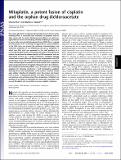Mitaplatin, a Potent Fusion of Cisplatin and the Orphan Drug Dichloroacetate
Author(s)
Lippard, Stephen J.; Dhar, Shanta
DownloadDhar-2009-Mitaplatin, a potent.pdf (1006.Kb)
PUBLISHER_POLICY
Publisher Policy
Article is made available in accordance with the publisher's policy and may be subject to US copyright law. Please refer to the publisher's site for terms of use.
Terms of use
Metadata
Show full item recordAbstract
The unique glycolytic metabolism of most solid tumors, known as the Warburg effect, is associated with resistance to apoptosis that enables cancer cells to survive. Dichloroacetate (DCA) is an anticancer agent that can reverse the Warburg effect by inhibiting a key enzyme in cancer cells, pyruvate dehydrogenase kinase (PDK), that is required for the process. DCA is currently not approved for cancer treatment in the USA. Here, we present the synthesis, characterization, and anticancer properties of c,t,c-[Pt(NH[subscript 3])[subscript 2](O[subscript 2]CHCl[subscript 2])[subscript 2]Cl[subscript 2]], mitaplatin, in which two DCA units are appended to the axial positions of a six-coordinate Pt(IV) center. The negative intracellular redox potential reduces the platinum to release cisplatin, a Pt(II) compound, and two equivalents of DCA. By a unique mechanism, mitaplatin thereby attacks both nuclear DNA with cisplatin and mitochondria with DCA selectively in cancer cells. The cytotoxicity of mitaplatin in a variety of cancer cell lines equals or exceeds that of all known Pt(IV) compounds and is comparable to that of cisplatin. Mitaplatin alters the mitochondrial membrane potential gradient (Δψm)[delta psi m] of cancer cells, promoting apoptosis by releasing cytochrome c and translocating apoptosis inducing factor from mitochondria to the nucleus. Cisplatin formed upon cellular reduction of mitaplatin enters the nucleus and targets DNA to form 1,2-intrastrand d(GpG) cross-links characteristic of its own potency as an anticancer drug. These properties of mitaplatin are manifest in its ability to selectively kill cancer cells cocultured with normal fibroblasts and to partially overcome cisplatin resistance.
Date issued
2009-12Department
Massachusetts Institute of Technology. Department of Chemistry; Koch Institute for Integrative Cancer Research at MITJournal
Proceedings of the National Academy of Sciences of the United States of America. (PNAS)
Publisher
National Academy of Sciences
Citation
Dhar, S., and S. J. Lippard. “Mitaplatin, a potent fusion of cisplatin and the orphan drug dichloroacetate.” Proceedings of the National Academy of Sciences 106.52 (2009): 22199-22204.
Version: Final published version
ISSN
0027-8424
1091-6490